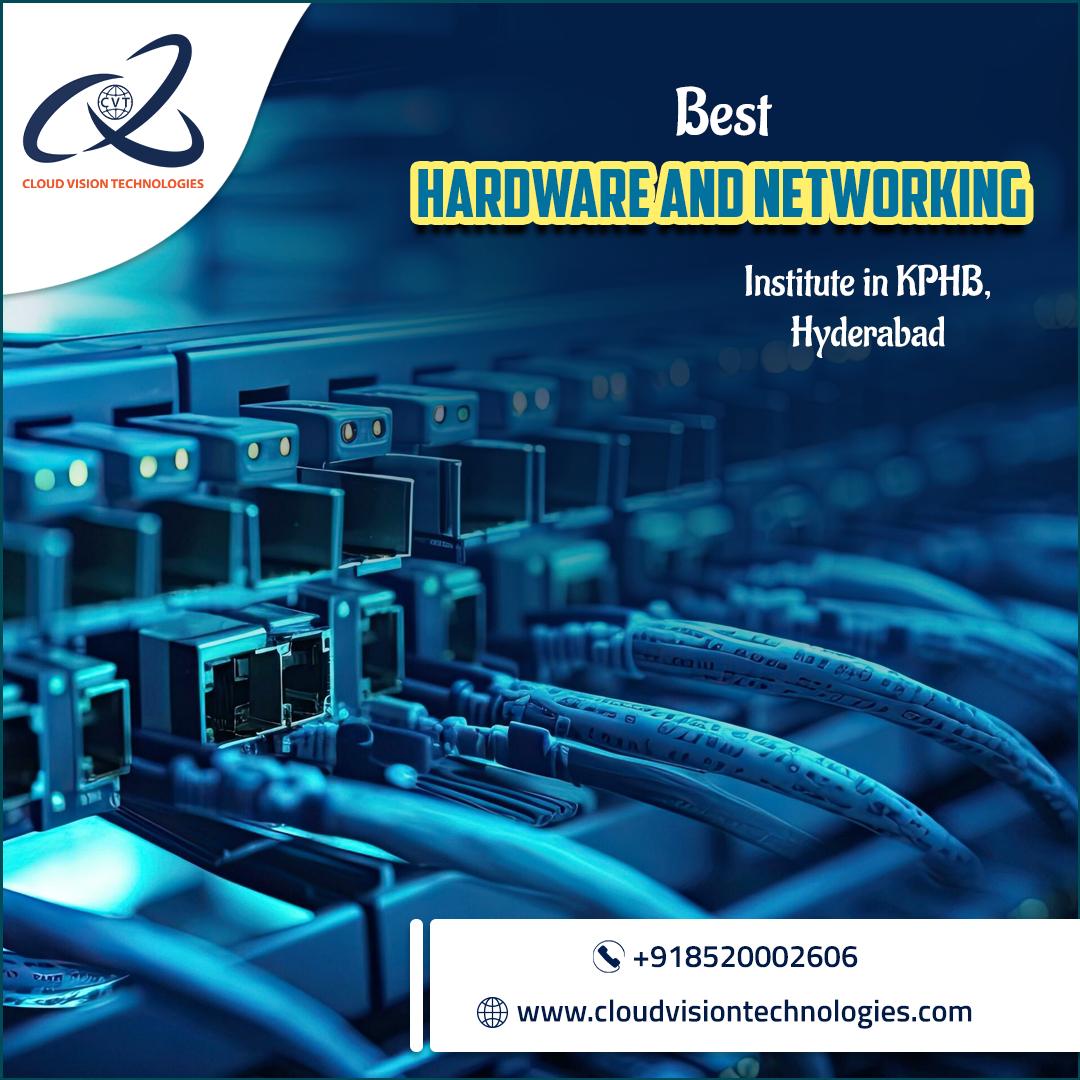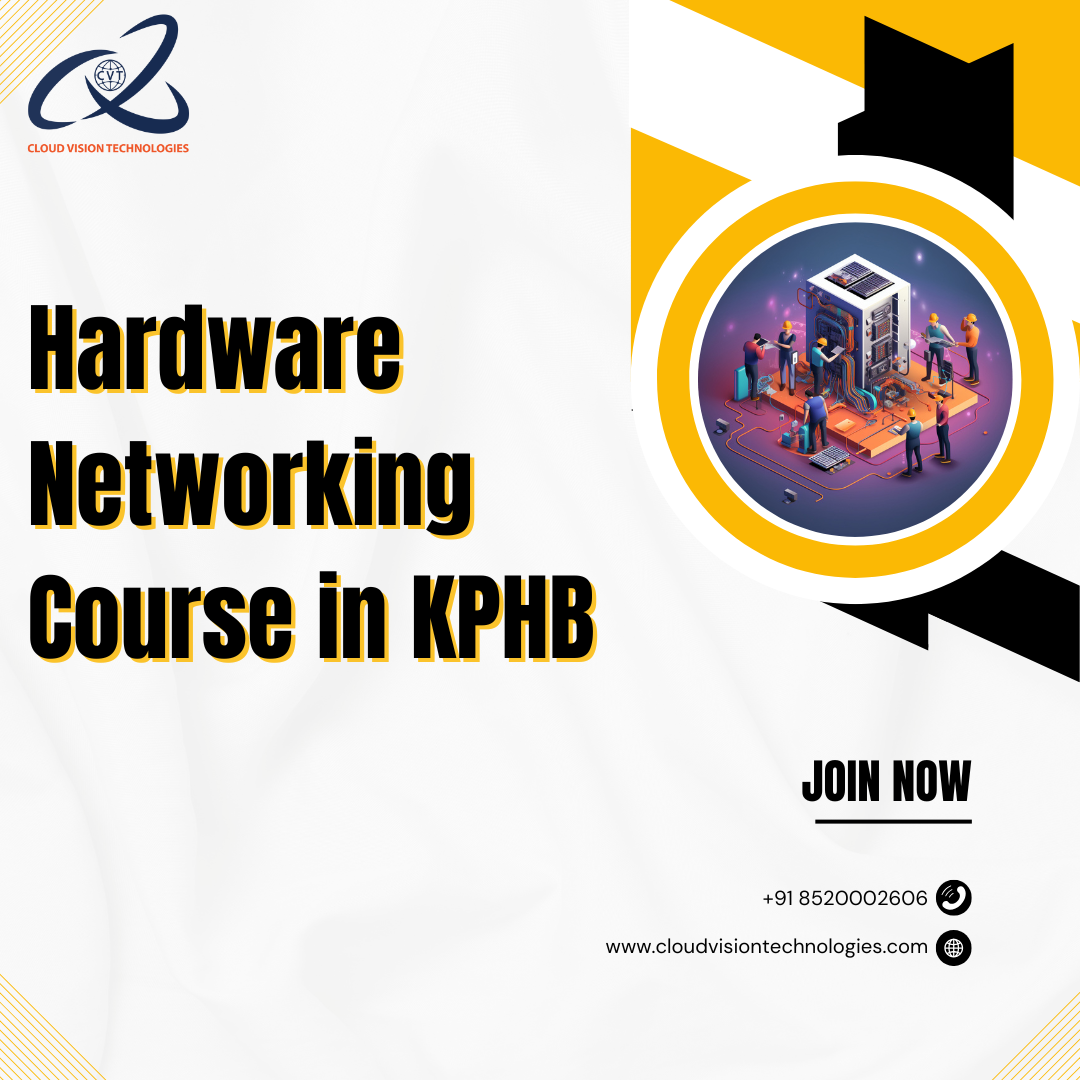
Hardware & Networking Course
Introduction to Hardware Networking:
Hardware & Networking Course, In today’s fast-paced digital world, where technology is deeply integrated into every aspect of our lives, hardware and networking form the foundational backbone of all computing systems. From simple tasks like checking emails on a smartphone to running complex data centers that power global businesses nothing would be possible without reliable hardware and efficient networking. Cloud Vision Technologies.
At its core, hardware refers to the tangible components of a computer system, the parts you can physically touch and see. These include input devices like keyboards and mice, output devices like monitors and printers, internal components such as processors, RAM, and motherboards, and external storage solutions. Each piece plays a specific role in making a computer function seamlessly. Hardware & Networking Course.
Networking, on the other hand, is what connects individual systems together. It allows computers, devices, and servers to communicate with one another, share data, access resources, and stay connected to the internet. Whether it’s a small office network or the vast infrastructure of the internet itself, networking ensures information flows quickly, securely, and reliably. Hardware & Networking Course.

What is Computer Hardware?
Computer hardware refers to the physical components of a computer system essentially, the parts you can see and touch. These hardware elements work together to carry out the instructions provided by software. Without hardware, a computer simply cannot function.
Hardware can be broadly classified into several categories: input devices, output devices, storage devices, and internal components. Hardware & Networking Course.
Input devices are the tools that allow users to interact with and give commands to the computer. Common examples include the keyboard, mouse, and scanner. The keyboard is used for typing and entering commands, while the mouse helps navigate the graphical user interface. Scanners are used to convert physical documents into digital form, making it easier to store or edit them. Hardware & Networking Course.
Output devices, on the other hand, are used to display or communicate the results of the computer’s processes to the user. The monitor, for example, displays visual output, while printers produce physical copies of documents. Speakers convert digital audio signals into sound, allowing us to listen to music, videos, or system notifications. Hardware & Networking Course.
Storage devices play a crucial role in retaining data and programs. Hard drives and SSDs (Solid-State Drives) are used to store large amounts of data permanently, including the operating system, software applications, and user files. USB flash drives serve as portable storage options that can be easily transferred between systems. Hardware & Networking Course.
Internal components are the core parts found inside the computer’s case that carry out the essential functions of the system. The motherboard is the main circuit board that connects all components. The CPU (Central Processing Unit) is often referred to as the brain of the computer that performs calculations and executes instructions. RAM (Random Access Memory) is responsible for temporarily holding data and instructions that the CPU needs while performing tasks, enabling faster processing. The power supply unit ensures that each component receives the necessary electrical power, and the graphics card handles the rendering of images and videos, particularly important for gaming, design, and video editing.
What is Networking?
Networking is the process of connecting two or more computers and other electronic devices to enable communication, data sharing, and resource access. It plays a crucial role in both small-scale setups, like home offices, and large-scale environments such as corporate IT infrastructures. Networking allows devices to work together by establishing pathways for data to travel from one system to another. Hardware & Networking Course.
One of the key benefits of networking is that it allows users to share resources such as files, printers, software, and internet connections. For example, in an office environment, multiple employees can access a single printer or internet connection through a local network, improving efficiency and reducing costs. Hardware & Networking Course.
There are two main types of networks based on scale: LAN (Local Area Network) and WAN (Wide Area Network). A LAN connects devices within a small geographical area, such as a home, school, or office building. In contrast, a WAN spans a much larger area, often covering cities, countries, or even continents, the best example being the Internet itself. These networks are connected through various mediums and technologies to allow real-time data exchange and communication. Hardware & Networking Course.
Several key hardware devices make networking possible. Routers connect multiple networks together and direct data between them; most home routers connect a local network to the internet. Switches manage data traffic within a local network by sending information directly to the device that needs it. Modems convert digital data from your computer into signals that can be transmitted over telephone or cable lines, and vice versa. Network Interface Cards (NICs) are installed in computers and other devices to enable physical connection to a network. Hardware & Networking Course.
Networking can be done in two primary ways: wired and wireless. Wired networking uses Ethernet cables to physically connect devices. It typically offers faster speeds and more reliable connections, making it a popular choice in professional settings. Wireless networking (Wi-Fi), on the other hand, allows devices to connect without physical cables, providing flexibility and convenience especially for mobile devices and in homes or public spaces.

How Hardware and Networking
Hardware and networking are two pillars of modern computing that work hand in hand. While hardware forms the physical components of a system, networking ensures these components can communicate with each other and share data effectively. Their integration is what powers everything from simple home setups to complex enterprise infrastructures.
Network Interface Card (NIC)
Every computer or device that wants to connect to a network must have a Network Interface Card (NIC). This component serves as the bridge between the device and the network. It can be wired (Ethernet) or wireless (Wi-Fi), and its job is to send and receive data packets over the network. Without a NIC, a computer cannot participate in network communications.
Routers: The Internet Gateways
A router is a vital networking device that connects multiple hardware components like computers, smartphones, printers, and even smart appliances to a single internet connection. It not only directs traffic between devices in a local network but also manages how that traffic connects to external networks like the internet. Routers assign IP addresses to devices and ensure the right data reaches the right destination. Hardware & Networking Course.
Servers: Centralized Hardware Powerhouses
Servers are specialized hardware systems designed to provide services to other devices (clients) on a network. These services might include data storage, website hosting, application management, or database control. In both small businesses and large enterprises, servers act as central hubs that manage resources and streamline workflow. For example, a file server allows users to store and retrieve documents from a shared location, while a web server delivers websites to users across the world.
Switches and Firewalls: Traffic Managers and Protectors
Switches are hardware devices used to connect multiple devices within a local network. Unlike routers, which connect networks together, switches operate within the same network, ensuring that data is sent directly to the correct device. This improves speed and reduces unnecessary network congestion. Hardware & Networking Course.
Firewalls, on the other hand, are hardware or software systems that monitor and control incoming and outgoing network traffic. They protect devices from unauthorized access, viruses, and cyberattacks by creating a barrier between trusted internal networks and potentially untrusted external sources. Hardware & Networking Course.
Seamless Connectivity in Home and Office Environments
In everyday environments, hardware and networking come together to make digital life more convenient. In a home setup, your router connects laptops, smartphones, smart TVs, and gaming consoles to the internet, while switches (in advanced setups) handle local file transfers or streaming. In offices, networking allows employees to print from any desk, access shared files, communicate through emails or video calls, and use centralized databases all thanks to the integration of hardware and networking technologies.
This interconnection also supports remote access, enabling users to connect to their office systems from anywhere, and cloud computing, where data and applications are hosted on remote servers but accessed via networked devices. Hardware & Networking Course.
Careers in Hardware and Networking
With the rapid growth of technology and the increasing reliance on interconnected systems, the demand for professionals skilled in hardware and networking is higher than ever. Organizations across all sectors from education and healthcare to finance and IT depend on these experts to ensure their systems run smoothly and securely. Hardware & Networking Course.
Network Engineer
A Network Engineer designs, implements, and manages an organization’s network infrastructure. They ensure that the local and wide area networks (LANs and WANs) are running efficiently and securely. Their responsibilities often include configuring routers and switches, monitoring network performance, resolving connectivity issues, and optimizing network traffic. Network engineers play a vital role in keeping the communication between devices stable and uninterrupted. Hardware & Networking Course.
System Administrator
A System Administrator, or sysadmin, is responsible for maintaining and managing computer systems and servers within an organization. Their duties include installing software, updating operating systems, managing user accounts, and ensuring system security. They often act as the first line of defense when something goes wrong with the internal IT systems, making them a crucial part of the IT team. Hardware & Networking Course.
Technical Support Specialist
Technical Support Specialists provide help and guidance to users who are facing technical problems with their hardware or network connections. They may work in call centers, in-house IT departments, or as field technicians. Their work involves troubleshooting, diagnosing issues, replacing faulty components, and guiding users through solutions. Strong communication skills and patience are key in this role, as they often deal directly with non-technical users. Hardware & Networking Course.
IT Technician
An IT Technician handles the installation, configuration, and maintenance of computer systems, software, and peripheral equipment. They ensure that everything from desktops and printers to LAN setups and Wi-Fi networks is working properly. In small organizations, IT technicians often wear multiple hats, combining roles such as technical support, hardware maintenance, and basic network management. Hardware & Networking Course.
Hardware Engineer
Hardware Engineers design, develop, and test computer hardware components like processors, memory devices, circuit boards, and networking equipment. They often work with software developers to ensure hardware and software compatibility. Their work is crucial in improving the performance and efficiency of physical systems, and they often work in manufacturing, product development, or R&D environments. Hardware & Networking Course.
Network Security Specialist
A Network Security Specialist focuses on protecting an organization’s network from cyber threats and vulnerabilities. They implement firewalls, intrusion detection systems, and encryption technologies to prevent unauthorized access and data breaches. As cybersecurity becomes increasingly important, this role is gaining prominence in government, healthcare, banking, and IT services.

Why Learn Hardware and Networking?
In the ever-evolving world of technology, having a solid understanding of hardware and networking can be a game-changer. Whether you’re just starting your IT journey or looking to expand your skill set, this field offers both foundational knowledge and vast career opportunities. Let’s take a closer look at why learning hardware and networking is a smart move. Hardware & Networking Course.
Foundational Knowledge
Learning hardware and networking lays the groundwork for everything in the tech world. By understanding how a computer works, what each part does, how data moves within a system, and how devices connect you gain a clearer picture of technology as a whole. This knowledge serves as a stepping stone to more advanced fields like system administration, software development, cybersecurity, and cloud computing. It’s like learning how a car engine works before becoming a race car driver. You understand the machine from the inside out. Hardware & Networking Course.
High Demand Across Industries
Every business, no matter how small or large, relies on computer systems and networks to function. This makes IT support and network maintenance an essential part of daily operations. From hospitals and banks to retail stores and tech companies, there is a continuous demand for professionals who can keep systems running smoothly and securely. As more businesses transition to digital platforms and cloud services, the need for skilled hardware and networking professionals continues to rise.
Career Flexibility and Growth
One of the best things about entering the hardware and networking field is the flexibility it offers. You can start out as a technician or support specialist and gradually move into specialized roles like network administrator, cloud engineer, DevOps professional, or cybersecurity analyst. The skills you develop are highly transferable and can open doors to various paths in the IT industry. This means you’re not locked into a single job—you have room to explore and grow based on your interests. Hardware & Networking Course.
Enhanced Problem-Solving and Analytical Skills
Working in hardware and networking involves a lot of troubleshooting and critical thinking. Whether you’re diagnosing a faulty motherboard, solving a network outage, or securing a system against threats, you constantly engage your problem-solving abilities. Over time, this sharpens your analytical thinking and makes you a more efficient and confident IT professional. These skills aren’t just valuable in tech—they’re useful in any profession that values logic, attention to detail, and resourcefulness.
Hardware & Networking Course
This course is designed to provide you with a comprehensive understanding of both hardware and networking concepts. It covers the fundamentals of computer hardware, how different components work together to form a functional system, and how networks operate to connect devices and allow them to communicate. Whether you’re interested in becoming a network engineer, system administrator, or IT technician, this course offers the core knowledge necessary to excel in these roles. Hardware & Networking Course.
Through hands-on experience and detailed lessons, you will learn how to set up, troubleshoot, and maintain computer systems and networks. You’ll also be equipped to manage hardware configurations, solve common issues, and implement networking solutions that enhance performance, security, and scalability. Hardware & Networking Course.

Conclusion
Hardware and networking are the core pillars of modern computing. They ensure that our devices work efficiently, data is transmitted securely, and systems stay connected 24/7. Whether you’re a tech enthusiast, a student, or someone looking to enter the IT field, understanding hardware and networking is a valuable skill that opens doors to numerous career opportunities. Hardware & Networking Course.
Learning hardware and networking is more than just plugging in cables or fixing computers. It’s about understanding the core of how modern technology operates and being able to keep it all connected, secure, and efficient. Whether you’re a beginner, a student, or someone looking for a new direction in your career, diving into this field can offer you a strong foundation, job security, and the ability to branch into exciting tech domains in the future. Hardware & Networking Course.
A Hardware & Networking Course offers the knowledge and practical skills needed to excel in today’s digital world. Whether you’re starting a new career or looking to upgrade your existing skills, this course provides you with a solid foundation in the essential aspects of IT. Gain hands-on experience, learn industry best practices, and open the door to various exciting career opportunities in the world of technology.
Address: Cloud Vision Technologies
Location: Samhitha Enclave, 3rd floor, KPHB Phase 9, Kukatpally, Hyderabad, Telangana – 500072
Contact Number : +91 8520002606
Mail ID: info@cloudvisiontechnologies.com
Website: https://www.cloudvisiontechnologies.com





